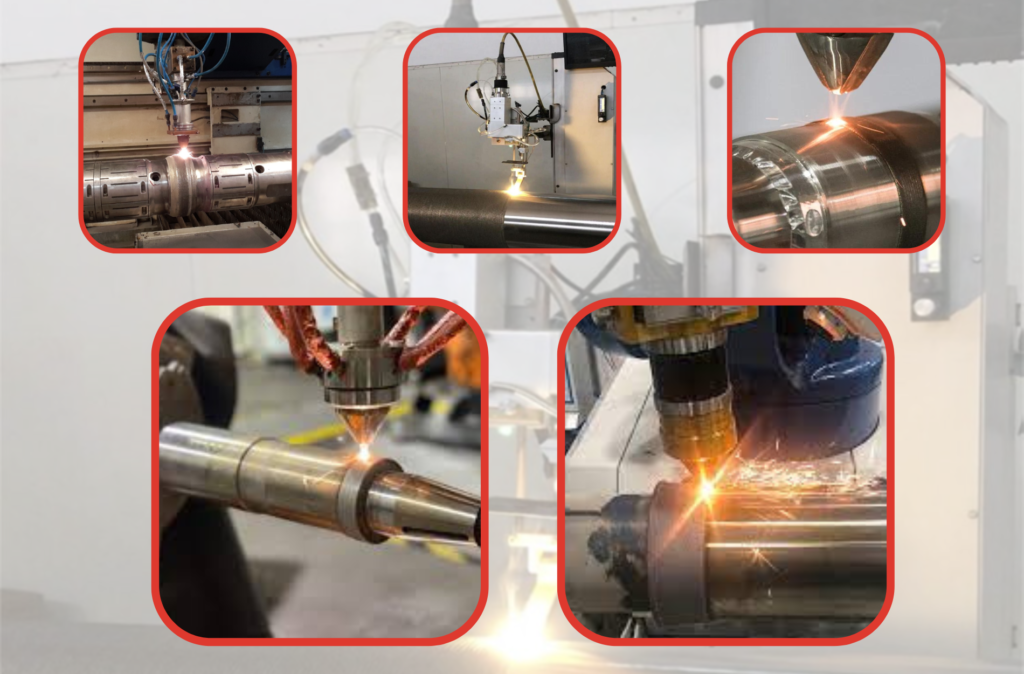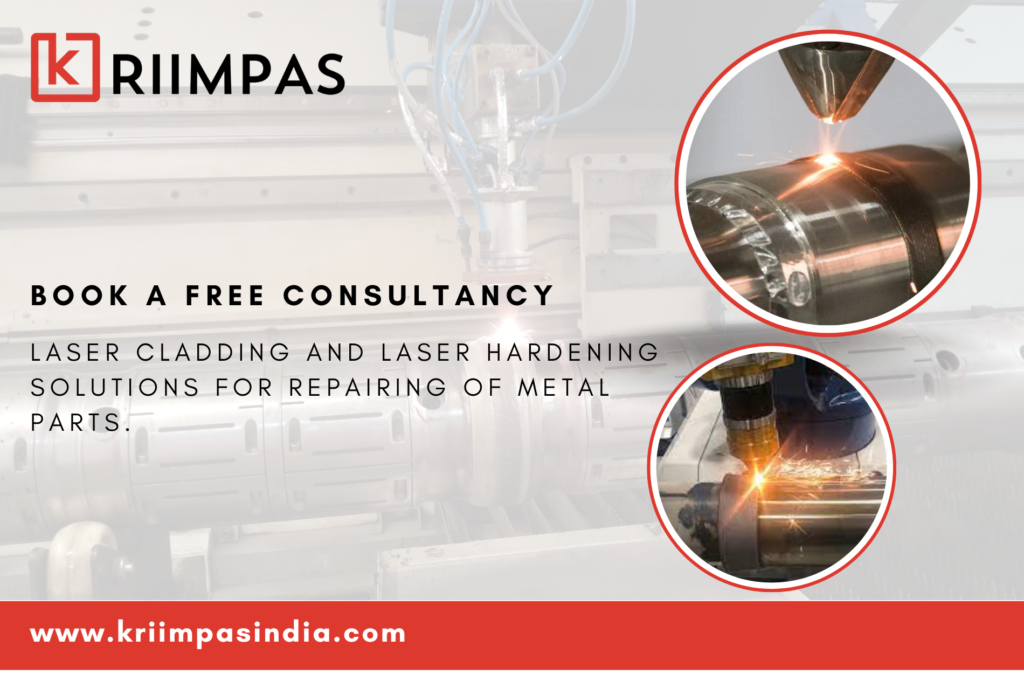
What is laser cladding and laser hardening?
Laser cladding and laser hardening are both techniques that use high-powered lasers to modify the properties of a material’s surface, but they achieve different goals:
Laser Cladding
- Focuses on adding a new layer of material to the surface.
- A laser beam melts either metal powder or wire fed into the beam, creating a molten pool on the surface.
- This molten pool then fuses with the underlying material and quickly cools, forming a strong metallurgical bond.
- The added layer, or cladding, can be chosen to provide specific properties like corrosion resistance, wear resistance, or improved high-temperature performance.
Laser Hardening
- Aims to modify the properties of the existing surface itself.
- A high-powered laser beam heats a localized area of the surface very rapidly.
- This rapid heating induces a phase transformation in the material, typically creating a martensitic microstructure which is very hard and wear-resistant.
- The laser beam then moves across the surface, creating a hardened track.
- Laser hardening is beneficial for components that need high surface strength but minimal distortion to the overall shape.
Here’s a table summarizing the key differences:
| Feature | Laser Cladding | Laser Hardening |
|---|---|---|
| Purpose | Add a new layer of material | Modify existing surface properties |
| Material Addition | Yes (powder or wire) | No |
| Focus | Surface features, corrosion resistance, wear resistance | Surface hardness, wear resistance |
| Result | New layer with desired properties | Hardened surface layer |
| Distortion | Potentially more distortion due to adding material | Less distortion due to localized heating |
Advantages to use laser cladding over traditional system
- Superior Precision and Control:
- Laser beams allow for highly precise application of the cladding material, exactly where it’s needed.
- This minimizes waste and reduces the need for extensive post-processing like grinding.
- Cladding thickness can be accurately controlled, sometimes achieving thinner layers with similar performance compared to traditional methods.
- Reduced Heat Distortion:
- Lasers deliver a concentrated heat source, minimizing heat input into the surrounding material.
- This reduces warping and distortion of the base component, especially important for delicate parts.
- Stronger Bond and Lower Porosity:
- The laser melting process creates a deep metallurgical bond between the cladding and the substrate.
- This bond is stronger than mechanically bonded coatings, leading to better performance and wear resistance.
- Additionally, laser cladding minimizes voids or porosity within the clad layer, further enhancing its strength.
- Wider Material Compatibility:
- Laser cladding can work with a broader range of cladding materials, including exotic alloys and metal matrix composites.
- This allows for tailoring the surface properties to specific needs.
- Environmentally Friendly:
- Laser cladding uses less energy compared to traditional methods, reducing its environmental footprint.
- There’s also less need for harmful fumes and hazardous materials associated with some cladding techniques.
- Potential for Automation:
- The precise and controlled nature of laser cladding makes it well-suited for automation, improving process consistency and repeatability.
Overall, laser cladding offers a more precise, controllable, and versatile approach to surface modification compared to traditional systems. While the initial investment might be higher, the benefits often translate to improved product quality, reduced rework, and potentially lower lifecycle costs.
Automation and Flexibility: Adaptable Laser Cladding and Hardening Solutions
In the realm of laser cladding and hardening, automation and flexibility are key factors for offering adaptable solutions. Let’s explore how they work together:
Automation Advantages:
- Increased Throughput: Automating tasks like robot-controlled laser manipulation and powder/wire feed significantly boosts production speed, especially for high-volume jobs.
- Improved Consistency: Automating process parameters minimizes human error, leading to consistent results in terms of clad layer thickness, depth of hardening, and overall quality.
- Reduced Labor Costs: Automating repetitive tasks frees up skilled personnel for tasks requiring human expertise, potentially reducing overall labor costs.
Flexibility Benefits:
- Material Adaptability: Automate parameter adjustments based on the chosen cladding material or base metal composition, ensuring optimal results for various combinations.
- Geometry Accommodation: Integrate flexible robotic systems or programmable work stages to handle components with complex geometries or varying sizes.
- Process Customization: Offer the ability to adjust laser power, scan patterns, and travel speeds within the automated system, allowing for fine-tuning of the cladding or hardening process for specific applications.
Adaptable Solutions in Action:
- Pre-programmed Profiles: Develop a library of pre-programmed laser parameters for common material combinations and component geometries. Operators can then select the appropriate profile for a specific job, ensuring consistent results without extensive manual setup.
- Sensor Integration: Incorporate sensors to monitor factors like melt pool temperature or surface hardness in real-time. The automation system can then adjust process parameters on the fly to maintain optimal conditions.
- Offline Programming: Enable offline programming of laser paths and process parameters for complex components. This allows for efficient setup and reduces machine downtime.
By combining automation with these flexible features, you can provide laser cladding and hardening solutions that are:
- Highly Efficient: Automate tasks while offering flexibility for various jobs, maximizing production output.
- Precise and Consistent: Ensure consistent results through automation with the ability for customization based on specific needs.
- Scalable and Adaptable: Handle diverse production demands with the ability to adapt to changing requirements.
Contact us now for better Solutions:
Kriimpas India Pvt. Ltd. is committed to partnering with you to optimize your manufacturing processes and achieve superior results. Contact us today to discuss how our laser cladding and hardening solutions can benefit your business.

GET A FREE CONSULTANCY

